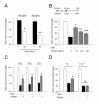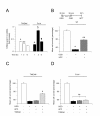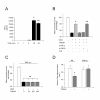The cytokine tumor necrosis factor-like weak inducer of apoptosis and its receptor fibroblast growth factor-inducible 14 have a neuroprotective effect in the central nervous system
- PMID: 22394384
- PMCID: PMC3311607
- DOI: 10.1186/1742-2094-9-45
The cytokine tumor necrosis factor-like weak inducer of apoptosis and its receptor fibroblast growth factor-inducible 14 have a neuroprotective effect in the central nervous system
Abstract
Background: Cerebral cortical neurons have a high vulnerability to the harmful effects of hypoxia. However, the brain has the ability to detect and accommodate to hypoxic conditions. This phenomenon, known as preconditioning, is a natural adaptive process highly preserved among species whereby exposure to sub-lethal hypoxia promotes the acquisition of tolerance to a subsequent lethal hypoxic injury. The cytokine tumor necrosis factor-like weak inducer of apoptosis (TWEAK) and its receptor fibroblast growth factor-inducible 14 (Fn14) are found in neurons and their expression is induced by exposure to sub-lethal hypoxia. Accordingly, in this work we tested the hypothesis that the interaction between TWEAK and Fn14 induces tolerance to lethal hypoxic and ischemic conditions.
Methods: Here we used in vitro and in vivo models of hypoxic and ischemic preconditioning, an animal model of transient middle cerebral artery occlusion and mice and neurons genetically deficient in TWEAK, Fn14, or tumor necrosis factor alpha (TNF-α) to investigate whether treatment with recombinant TWEAK or an increase in the expression of endogenous TWEAK renders neurons tolerant to lethal hypoxia. We used enzyme-linked immunosorbent assay to study the effect of TWEAK on the expression of neuronal TNF-α, Western blot analysis to investigate whether the effect of TWEAK was mediated by activation of mitogen-activated protein kinases and immunohistochemical techniques and quantitative real-time polymerase chain reaction analysis to study the effect of TWEAK on apoptotic cell death.
Results: We found that either treatment with recombinant TWEAK or an increase in the expression of TWEAK and Fn14 induce hypoxic and ischemic tolerance in vivo and in vitro. This protective effect is mediated by neuronal TNF-α and activation of the extracellular signal-regulated kinases 1 and 2 pathway via phosphorylation and inactivation of the B-cell lymphoma 2-associated death promoter protein.
Conclusions: Our work indicate that the interaction between TWEAK and Fn14 triggers the activation of a cell signaling pathway that results in the induction of tolerance to lethal hypoxia and ischemia. These data indicate that TWEAK may be a potential therapeutic strategy to protect the brain from the devastating effects of an ischemic injury.
© 2012 Echeverry et al; licensee BioMed Central Ltd.
Figures






Similar articles
-
Tumor necrosis factor-like weak inducer of apoptosis and fibroblast growth factor-inducible 14 mediate cerebral ischemia-induced poly(ADP-ribose) polymerase-1 activation and neuronal death.Neuroscience. 2010 Dec 29;171(4):1256-64. doi: 10.1016/j.neuroscience.2010.10.029. Epub 2010 Oct 16. Neuroscience. 2010. PMID: 20955770 Free PMC article.
-
The interaction between tumor necrosis factor-like weak inducer of apoptosis and its receptor fibroblast growth factor-inducible 14 promotes the recruitment of neutrophils into the ischemic brain.J Cereb Blood Flow Metab. 2010 Jun;30(6):1147-56. doi: 10.1038/jcbfm.2009.280. Epub 2010 Jan 13. J Cereb Blood Flow Metab. 2010. PMID: 20068578 Free PMC article.
-
TWEAK/Fn14 pathway is a novel mediator of retinal neovascularization.Invest Ophthalmol Vis Sci. 2014 Feb 10;55(2):801-13. doi: 10.1167/iovs.13-12812. Invest Ophthalmol Vis Sci. 2014. PMID: 24408972 Free PMC article.
-
The TWEAK-Fn14 system as a potential drug target.Br J Pharmacol. 2013 Oct;170(4):748-64. doi: 10.1111/bph.12337. Br J Pharmacol. 2013. PMID: 23957828 Free PMC article. Review.
-
TWEAK as a target for therapy in systemic lupus erythematosus.Mol Biol Rep. 2011 Jan;38(1):587-92. doi: 10.1007/s11033-010-0144-9. Epub 2010 Apr 1. Mol Biol Rep. 2011. PMID: 20358293 Review.
Cited by
-
sTWEAK is a marker of early haematoma growth and leukoaraiosis in intracerebral haemorrhage.Stroke Vasc Neurol. 2021 Dec;6(4):528-535. doi: 10.1136/svn-2020-000684. Epub 2021 Mar 23. Stroke Vasc Neurol. 2021. PMID: 33758070 Free PMC article.
-
Urokinase-type plasminogen activator is a modulator of synaptic plasticity in the central nervous system: implications for neurorepair in the ischemic brain.Neural Regen Res. 2020 Apr;15(4):620-624. doi: 10.4103/1673-5374.266904. Neural Regen Res. 2020. PMID: 31638083 Free PMC article. Review.
-
TWEAK/Fn14 pathway modulates properties of a human microvascular endothelial cell model of blood brain barrier.J Neuroinflammation. 2013 Jan 15;10:9. doi: 10.1186/1742-2094-10-9. J Neuroinflammation. 2013. PMID: 23320797 Free PMC article.
-
A further TWEAK to multiple sclerosis pathophysiology.Mol Neurobiol. 2014 Feb;49(1):78-87. doi: 10.1007/s12035-013-8490-y. Epub 2013 Jul 20. Mol Neurobiol. 2014. PMID: 23873135 Review.
-
TWEAK and Fn14 in the Neurovascular Unit.Front Immunol. 2013 Nov 11;4:367. doi: 10.3389/fimmu.2013.00367. eCollection 2013. Front Immunol. 2013. PMID: 24273541 Free PMC article. Review.
References
-
- Kirino T, Nakagomi T, Kanemitsu H, Tamura A. Ischemic tolerance. Adv Neurol. 1996;71:505–511. - PubMed
-
- Kirino T. Ischemic tolerance. J Cereb Blood Flow Metab. 2002;22:1283–1296. - PubMed
-
- Roger VL, Go AS, Lloyd-Jones DM, Adams RJ, Berry JD, Brown TM, Carnethon MR, Dai S, De SG, Ford ES, Fox CS, Fullerton HJ, Gillespie C, Greenlund KJ, Hailpern SM, Heit JA, Michael HP, Howard VJ, Kissela BM, Kittner SJ, Lackland DT, Lichtman JH, Lisabeth LD, Makuc DM, Marcus GM, Marelli A, Matchar DB, McDermott MM, Meigs JB, Moy CS, Mozaffarian D, Mussolino ME, Nichol G, Paynter NP, Rosamond WD, Sorlie PD, Stafford RS, Turan TN, Turner MB, Wong ND, Wylie-Rosett J, Roger VL, Turner MB. Executive summary: heart disease and stroke statistics-2011 update: a report from the American heart association. Circulation. 2011;123:459–463. - PMC - PubMed
Publication types
MeSH terms
Substances
Grants and funding
LinkOut - more resources
Full Text Sources

